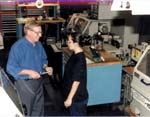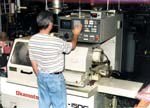Getting A Grinding Bonus
When this company traded its vintage ID grinders for CNC machines, it got more grinding capacity/capability than it expected.
Share




ECi Software Solutions, Inc.
Featured Content
View More





In today's world, many new products fail to live up to buyers' expectations. One new product not only met the user's expectations, but it provided a number of unlooked-for benefits as well.
Rexnord Corp., an Invensys Automation Systems company, makes self-aligning roller bearings for aerospace and industrial applications from bearing-quality steel at its Downers Grove, Illinois, manufacturing facility. The roller bearings have three major parts: an inner ring, an outer ring and the rollers, which the plant turns from bar stock and grinds to demanding size and finish requirements. The plant heat treats and plates the machined components and assembles them with retaining rings, seals, dust shields and other lesser components into finished bearings ready for shipment.
Finish grinding of outer rings was performed on the plant's four older hydraulic ID grinders. The outer rings are precision parts that must be held to close tolerances, but it became increasingly difficult to produce the parts because the machines were wearing out. Experienced operators had to be present at all times to make the adjustments constantly needed to keep parts within specifications.
The plant had to either rebuild its hydraulic ID grinders or replace them. Some initial quotes indicated that rebuilding the grinders would be an expensive proposition, but that was not the only consideration.
Rexnord makes its self-aligning roller bearings in relatively small lot sizes—runs of 50 to 250 pieces are typical—necessitating frequent setups. Typical setup time for the hydraulic ID grinder was about 6½ hours, which bottlenecked the process and frustrated attempts at improving productivity—at a time when the company was looking for ways to transform itself into a lean manufacturing operation.
The vintage ID grinding machines required experienced setup people and skilled operators familiar with the idiosyncrasies of the machines and able to compensate for them. The grinding department at Rexnord is fortunate because it still has such personnel. However, the availability of qualified setup people and operators in the metalworking field continues to decline, and Rexnord knew it had to take steps to make its grinding operations less labor intensive. Having the existing ID grinders rebuilt seemed the wrong choice because it would only perpetuate the department's dependence on a large number of skilled setup people and operators.
A Shift To CNC
Rexnord decided to replace the four hydraulic ID grinders with new CNC ID grinders. Although other departments in the plant had been operating CNC machine tools for years, the transition to CNC bypassed the grinding department. The department's purchase of the CNC ID grinder represented its first hands-on encounter with the technology. After studying the machines on the market, the company decided that the Model IGM-15CNC internal grinder from Okamoto Corp. (Buffalo Grove, Illinois) offered the best price/performance combination.
The CNC grinder is considerably more versatile than the hydraulic grinder it replaced. Its programming menu provides for four types of grinding: straight, taper, face and multi-step. And where the older machine was limited to ID grinding exclusively, the CNC machine can grind IDs, ODs and faces in a single chucking for improved accuracy and optimum productivity.
The machine can grind internal diameters from 0.24 inch to 6 inches. It has a 5-inch grinding stroke and a 10-inch swing. Its workhead can swivel from -5 degrees to 15 degrees. Available spindle speeds are 10,000 rpm to 120,000 rpm. A combination of an AC servomotor and a precision ballscrew enables infeed increments as fine as 0.000010 inch. The grinder's workhead speed is infinitely variable from 100 to 850 rpm and is programmable through the CNC.
The grinder comes with a Fanuc 18T CNC control, which Okamoto describes as ideal for operators new to CNC ID grinding. Nevertheless, the grinding department personnel at Rexnord were starting at ground zero where computer control of the machines was concerned, and the department heads felt that they needed something extra to make the control as easy to learn and use as possible.
"We needed to make the transition from our manually operated machines to the CNC age, and we needed to make that transition as smooth as possible for our setup people and our operators," emphasizes Skip Bahr, grinding superintendent at the Downers Grove plant. "Okamoto helped us by creating ‘templates' for the families of parts that we grind. The templates make programming the machine for the next part easier than using the control's standard programming software."
"With the templates, we can usually change over from one part in a family to another in about one-third less time than it took with the hydraulic grinders," says Ljubisa Srejic, setup man at the plant. "Another important advantage of the CNCs is their consistent accuracy. Where the size would drift on the older machines, the new machines can hold 0.0002 inch consistently all day long."
Once the first CNC grinder proved successful, Rexnord added a second, third and fourth machine, grouping them in a cell (photo on page 83). All of the work formerly done on the older hydraulic grinders was transferred to the CNC grinders. Where each of the hydraulic grinders required an operator, in the cell two CNC grinders are run by one operator who loads parts into the fixtures, monitors the operation of the two machines, replaces grinding wheels when necessary and performs in-process inspection of ground parts.
The CNC grinders not only provide more accurate parts with better finishes, resulting in better roller bearings, but they have enabled the company to reduce its parts inventory as well. "Our customers specify the amount of radial clearance they require in their bearings," explains Mr. Bahr. "To provide bearings with the desired clearance, we do selective assembly using appropriately sized parts from inventory. When we made the parts on the older grinders, we would maintain a large inventory of parts of various sizes because it was too difficult to machine them to precise size on an as-needed basis. With the Okamoto grinders, we can grind parts to required size on an as-needed basis. As a result we have been able to considerably reduce our inventory."
Faster setups, more accurate parts with better finishes, a smooth transition from hydraulic machines to computer-controlled machines, reduced labor costs, reduced inventory costs—it's a success story that could certainly end here. But the story gets better.
The grinding department also has three universal grinders that are about as old as but considerably more versatile than the shop's vintage ID grinders. Where the ID grinders were set up for production grinding of bearing races, the universal grinders were used for other parts requiring more diverse operations.
"The universal grinder is more of a tool room machine than a production machine," explains setup man Tom Vana. "Because of its versatility, we went to the machine for surface grinding, bore grinding, OD grinding and a number of different operations that we couldn't do on our hydraulic ID machines.
"We still rely on our universal grinders for prototype work," Mr. Vana continues. "Because they are so versatile, we can grind parts on them that would require special fixtures and other tooling on another type of machine. With the universal we can determine quickly, and with a minimum cost for tooling, what will be needed to get a part into production."
However, the universal machines are just as old as the department's hydraulic ID grinders, and they suffer from many of the same problems. Mr. Vana explains that the operators must constantly make adjustments to the universals to keep them on size. Because machine wear has affected accuracy and repeatability, operators are reluctant to grind aggressively for fear of making scrap. And because the operators nurse the machines through operations, part cycle times are less than optimal.
The greater versatility of the universal machine also means that more things can go wrong. The universals require more attention from the operator than the hydraulic ID machines, and operator training on the machines is longer and more costly. In short, Rexnord faced many of the problems with its universals that plagued its hydraulic ID grinders.
Same Solution
Because of the faster setups and greater productivity of the CNC ID grinders, the machines were able to handle the work formerly done on the hydraulic ID grinders, but they were nowhere near being used to capacity. Where the former machines were limited to ID work, the CNC machines are more flexible. They can straight bore grind, plunge grind, angle grind, radius grind, step grind, and ID and OD grind—many of the operations that in the past were relegated to the universal machines. As a result, the department began shifting work from the universals to the CNC grinders.
The amount of work transferred from the universals to the CNC quickly grew from a trickle to a flood. "The CNC grinders are so much more productive and easier to operate than the universals that we were able to offload quite a bit of work," reports Mr. Bahr. "We have moved 50 to 75 percent of our aerospace work from the universals to the CNC ID machines," adds Mr. Vana. "The only reason that we haven't transferred more of the work is that some parts are too large for the newer machines to handle. The universals have a 10-inch chuck as opposed to a 6-inch chuck for the CNC machines."
Rexnord is essentially doing on the four CNC machines what formerly required four hydraulic ID grinders and three universal grinders. The unexpected bonus grinding capability has greatly increased the efficiency of the plant's grinding department and is very much in line with the company's declared goal of becoming a lean manufacturing operation, which the company views as a key to survival in the long term.
Related Content
Quick-Change Tool Heads Reduce Setup on Swiss-Type Turning Centers
This new quick-change tooling system enables shops to get more production from their Swiss turning centers through reduced tool setup time and matches the performance of a solid tool.
Read MoreInside the Premium Machine Shop Making Fasteners
AMPG can’t help but take risks — its management doesn’t know how to run machines. But these risks have enabled it to become a runaway success in its market.
Read MoreLean Approach to Automated Machine Tending Delivers Quicker Paths to Success
Almost any shop can automate at least some of its production, even in low-volume, high-mix applications. The key to getting started is finding the simplest solutions that fit your requirements. It helps to work with an automation partner that understands your needs.
Read MoreCNC Machine Shop Honored for Automation, Machine Monitoring
From cobots to machine monitoring, this Top Shop honoree shows that machining technology is about more than the machine tool.
Read MoreRead Next
Setting Up the Building Blocks for a Digital Factory
Woodward Inc. spent over a year developing an API to connect machines to its digital factory. Caron Engineering’s MiConnect has cut most of this process while also granting the shop greater access to machine information.
Read MoreBuilding Out a Foundation for Student Machinists
Autodesk and Haas have teamed up to produce an introductory course for students that covers the basics of CAD, CAM and CNC while providing them with a portfolio part.
Read MoreRegistration Now Open for the Precision Machining Technology Show (PMTS) 2025
The precision machining industry’s premier event returns to Cleveland, OH, April 1-3.
Read More

.png;maxWidth=150)

























%20outer%20bearing%20race.jpg;width=860)









.jpg;maxWidth=300;quality=90)








